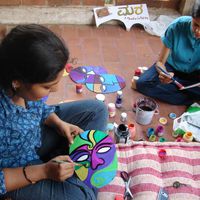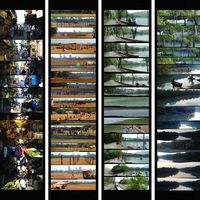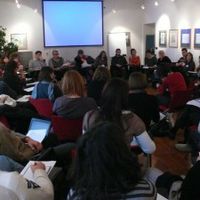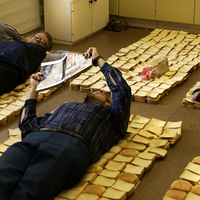Perceiving cultural rights | Politics of development and food production (Part 2)
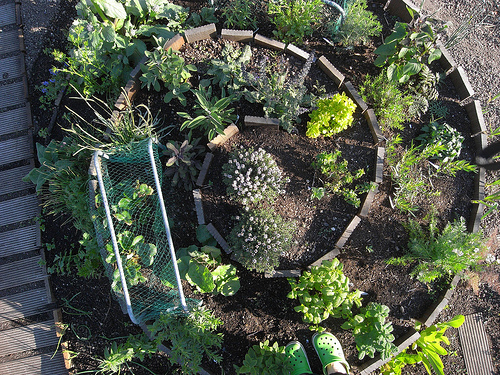
In the part 2 of the "perceiving cultural rights" series, culture36.org contributor, Deepak Srinivasan analyses the Cultural Rights discourse as a new and emerging one, intrinsically tied to processes of the political. He investigates cultural rights in relation to the politics of development and food production, with 2 case studies from Greece and Belgium.
Critiquing Development
[caption id="attachment_11016" align="alignright" width="300" caption="SO ON rooftop-garden"]
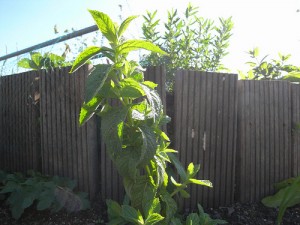 [/caption]
[/caption]Social sector groups that work with current development paradigms in Africa and Asia (while working to incorporate media and digital tools) are slowly recognizing the need to move beyond infrastructural and technological development alone. These regions are posing inquiries for culturally relevant content and communication. Specifically, re-envisioning and retention of traditional practices, for ecological and sustainable modes of living are being much explored in this context. A deeper relationship that addresses the role of culture in ecological crises is being engaged with. To be able to do so, changing economies that are intrinsically linked to livelihoods and traditional practice are being re-examined.
Growing critique of industrial modernism in developing nations in Asia and Africa has proposed restating and re-affirming the role of agrarian practice in modern societies. The 20th century saw neat divisions such as urban and rural, each space producing its own “lifestyle” and livelihood. The aspirational quality of the urban, equated to mean “modern” was highlighted, and development was articulated as ascension of all things rural (traditional) towards modern. The second stream of thought was modernization of rural livelihood and mechanisation of agriculture. Today one realizes the detrimental effects of such imaginations that have produced such divisions and definitions of space. As a consequence, one sees changes in traditional practices, livelihoods and food production.
Out of concern of food production politics, or for livelihoods of the ‘rural’ agriculturist, many artist and interdisciplinary practitioner led initiatives have been proposed. One such interesting proposal is, The Ark: Land, Biodiversity, and Architecture initiative led by architects and researchers, Phoebe Giannisi & Zissis Kotionis. Located in Greece, the project consisted of a series of activities aiming to bring the urban dweller closer to agrarian issues. The most unique aspect of the Ark however, has been in combining cultural and ecological by focusing on activities and conversations on biodiversity of seeds, human networking through exchange of seeds and nutrition concerns in the post-industrial era.
The Ark Vs Noah’s Ark
[caption id="attachment_11014" align="alignright" width="300" caption="Poebe and Zissis Kotonis-The Ark presentation"]
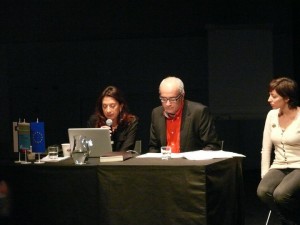 [/caption]
[/caption]Zissis Kotonis while talking about the Ark project elaborates on choosing Noah’s ark iconography, as it possessed a collective “cultural unconsciousness”. The mythical Noah’s Ark’s role could be articulated as working with a condition that nature produced. Kotonis departs from biblical thought in stating that the new construction of the Ark is to address situations human actions have created (as opposed to nature’s wrath). The Ark also comments on the legend of Noah by placing the possibilities of solutions in human action, as opposed to relying on a heavenly one.
The Ark: Land, Biodiversity, and Architecture initiative (http://www.arhitext.com/english/2011/02/phoebe-giannisi-zissis-kotionis-the-ark/) looked at new grown notions of land and habitation from a lens of the actual Greek landscape (which has both cultivation and building). By doing so, the project validates traditional Greek culture and its relationship to cultivation. Phoebe Giannisi & Zissis Kotionis say, “natural ground is more and more habited ground, the whole thing is constructed, we need to understand this construction and influence it in different ways… interweaving of cultivation into architecture reintroduces earth into city space”. Traditionally, city & countryside have been artificially separated as sites of production & consumption respectively. The Ark project focuses on bringing geo-organisational polarities closer and through a mixed human-digital interface by challenging these separations. By connecting the agrarian to digital and the urban dweller to a physical exchange, networking- most often described as an attribute of urban culture- could be reinstated.
It is becoming clearer that cultural practices, beliefs and attitudes can bring about sustainable or detrimental ecological effects. It is evident that ecology collectively contributes to histo-geographic milieu; the milieu which in turn, is crucial to cultural practice. What needs to be asked then, to further this relationship between culture and ecology is, whether access to the traditional and the ecological constitute an important cultural right?
Urban Participation in localized green movements
[caption id="attachment_11015" align="alignright" width="300" caption="SO-ON Rooftop-garden"]
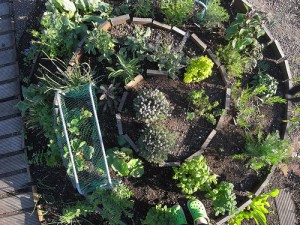 [/caption]
[/caption]The context of addressing ecological change in west Europe is set in the backdrop of urbanized, concretized cities with streets and sidewalks cemented from side to side. Streets of commerce and core activity areas of city have done away with green in functional and occupied space, and have instead designated confined zones for green space, as lung space. Media artist and activist, Annemie Maes’ art collective so-on (Brussels, Belgium based, http://so-on.be/) has sought to respond to such urban changes in ecology. So-on like many other artists or ecologists, with activist like agendas have been trying small and large green reclamations, some as grand as large scale rooftop eco-parks and cultivation areas. Annemie Maes describes eco-parks atop parking lots as rooftop forests. Three such forests have been grown to contribute to the skyline of Brussels- an edible forest garden, a wild flower garden and an urban permaculture system. The building being the skeletal framework is covered by green living skin; and the technology used works as the sensorial layer. So-on’s rooftop activities involve various actors from different disciplines with a common interest in their spaces they inhabit. The places they create are places with no names; in being nameless, these rooftops stand as political conversation in the landscape. For urban dwellings thus, the ecological acquires deeper cultural perspective of new social networks, food production, aesthetics, parallel economies and livelihoods.
Contentious focus: Asian agriculture vs neoliberal development
Neo-liberal India is one that liberalized its economy beginning the era of 1990s. The current neo-liberal economy has led to two nations in terms of its operational economy, livelihoods and cultural practices. A growing and upwardly mobile middle class has defined itself as the public in power, and therefore ones with legitimized citizenry. This middle class is fed a diet of corporate owned media and the issues it will cover, and is blissfully unaware of woes of the “other India”.
[caption id="attachment_11017" align="alignright" width="300" caption="So-on urban beehive, Brussels"]
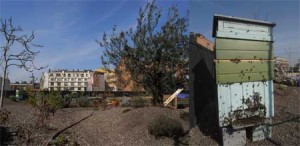 [/caption]
[/caption]A large population of the subcontinent subsists on very poor average incomes and hardly any nutrition in their affordable diet. On the one hand, many people living below the “poverty line” are unable to access enough food for their subsistence due to increasing prices. Ironically, it isn’t just an issue of affordability and lack of access to food to a certain large population group, but the food producer, the farmer is also facing dangerous consequences due to state policies. Indian economist Utsa Patnaik and social scientist/journalist P. Sainath paint a rather gloomy tale of happenings to the social milieu of the Indian farmer. Unfriendly state policies that are “free market” oriented have managed to produce startling statistics of farmer suicides- farmers who have been killing themselves due to burden of loans. Activist discourses of rights of farmers critiquing neoliberal policies have not shown much way forward in producing a public discussion and add political pressure.
Examples like The Ark: Land, Biodiversity, and Architecture and projects of Belgium based so-on offer possibilities of re-engaging a lax and indifferent south Asian middle class public to rekindle discussions on other occupational groups. More importantly, in a real estate driven globalizing “3rd world” market, reinterpretations of land use and land ownership become crucial in engaging and reinvestment in a new cultural fabric.
These projects were presented at the Ready for Change? Forum held in Ljubljana late last year. This writer was in attendance.
Deepak Srinivasan is an artist, media practitioner, researcher and pedagogue, currently a core member of Maraa (www.maraa.in), a media & arts collective based in Bangalore and faculty at Srishti School of Art, Design and Technology, Bangalore (www.srishti.ac.in). After a Bachelor’s degree in environmental sciences and an MS in neurobiology, his interests shifted to exploring the role of performance as method for trans-disciplinary inquiry. Since 2005, he has been training in performing arts and community theatre. Deepak’s experience in media comes from his days as content developer with Worldspace Satellite Radio. Media and art practice have become an emerging focus for Deepak and help to better understand the role of culture in emerging political negotiations and identities.
Similar content
08 Feb 2012
deadline
25 Aug 2023
deadline
19 Dec 2019

